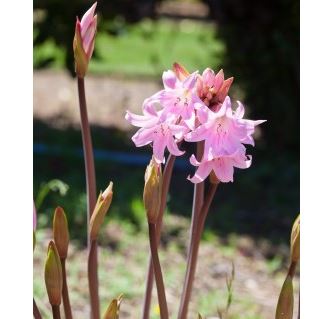





Differences between amaryliss (common name) and amaryliss belladonna (botanical name): The main characteristics when looking for the differences between these is this species has no leaves at flowering time, solid stems, and produces 6 -12 flowers, while the hippeastrum (amaryllis used for the common name) has leaves shortly after flowering, hollow stems and blooms 3 – 6 flowers.
For growing indoors I actually find the hippeastrum a much more attractive plant because it produces flowers and then it's surrounded by foliage. The belladonna is less popular among indoor growers and are only suitable for growing in greenhouses or a conservatory.
Foliage: Green strap shaped leaves appear during spring and then die back early summer after taking plenty of food reserves for the flowering period. One or two leafless solid stems appear from the bulb and flowers during late summer.
Flowering: During August or September fragrant pink or white funnel shaped flowers appear in clusters of 6 - 12 at the top of the leaf free reddish colored stalk.
Rest period: After the leaves die down, the bulb now has a resting period when dry soil is required - ready for the flower spike and flowers to appear during late summer.

You can grow the amaryllis belladonna indoors and if you can get them to flower they look very simple and attractive. However, I would say it's best to take a look at the hippeastrum species because it's much more suited for indoor growing and easier to get flowering.
Copyright © www.100flowers.win Botanic Garden All Rights Reserved